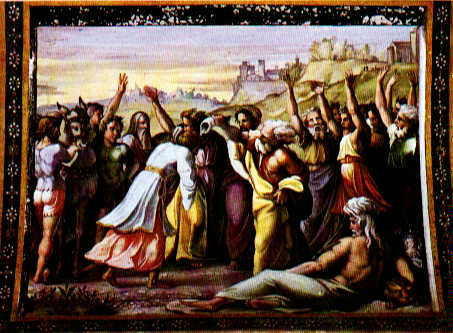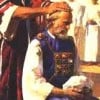Kahana and DNA

As mentioned previously, my family, the Kahana are of the
J2a4h haplotype, which immediately set those of the J1e haplotype on the
attack, proclaiming that they are true Kohenim, or priests and that we were not. A more ridiculous statement I could not
imagine, but since most of them are Rabbanites, I could expect little less of
them, since they have been taught from their onset in 200 BCE that the more
preposterous the statement the make, the more adherents they will garner. So nothing has changed amongst them and I
doubt it ever will. As Karaites, we are tied to the past. We know the past governs not only the present but the future as well. So our heritage is held sacred and therefore I will defend it much as my ancestors have done; with truths, with the Tanach, and with common sense.
So for those that would like to learn, that are seekers of the truth, then read on and I will try to explain how this confusion came about and why what they believed was their justification to have been so ready to pounce upon any other statements, was nothing more than a fallacy on their own part and only because they have numbers (almost 2:1 in haplotype numbers) they think they can force their opinion on others. Unfortunately, that has been the common denominator of human history. Those with the numbers, those that slaughtered or oppressed their opponents have been permitted to alter the truths to create their own history. But not any longer. The time has come to change what has been mistakenly believed and rectify the past so that we can herald a future based on truths.
Fact One:
For those that
comprehend genetic matrices and geometric progression, the first clue should
have been that those having the greatest number are least likely to be from the
original source. One of the ancients in
my family, a distant relative in Israel, Itzok, who passed away about fifteen
years ago, told me that in the end they will come to realize that which is
greatest is least, and that which is least is greatest. He was passing down to me a saying from his
ancestors that they kept for several thousand years when referring to the
Kahana. A small family that once served
as the Kohen Gadol, and over the centuries since the dispersion have been
superseded by other families proclaiming themselves as the one and only, even
though their numbers suggested they never could have been. As one of the J1e’s quoted to me from an episode
of Highlander, “In the end there can only be one.” Sadly, television has pervaded our concepts of
Jewish priesthood. The fact is that one
family primarily served in the capacity of Kohen Gadol, serving in the Temple,
but many families served as Kohenim throughout the countryside. Twenty-four orders were eventually reduced to
four over a period of one thousand years, and only from those families, Boethus,
See, Anan and Phiabi were the lines of the Kohen Gadol selected. There were two other families, Kamithos and
Theophilus, but they were so closely related to the main four lines and
therefore are not considered separately.
Meanwhile, there were hundreds of
other families that served as Kohenim throughout the land and they were only
distantly related to these four primary families. So while these hundreds of others married
amongst themselves, their genetics drifted and mutated over time to a
significant degree from those that served as Kohen Gadol. And as
the geometric progression would suggest, even after the persecutions,
genocides, etc., they would still be in far greater number by the year 2010 than the descendants of the
primary four families. Just as Itzok said to me, that the lesser is the greater, those who have opposed my family's claim to the legacy of Aaron based on our traditions should have recognized that their own numbers were just too great to support their being derived from a singular ancestor just a mere 3300 years ago.
Fact Two:
The J1e family members also will argue that their genetic matrix is younger than the J2a4h, and that it is. Almost 1500 years younger by some estimates. And as a result of that calculation, they are quick to argue that the J2a4h’s were in existence long before the Exodus and therefore couldn’t possibly be descended from Aaron but must be a subclass of his ancient Levite Ancestors. But here is where they make their chief error. For some reason they assume that Aaron would be of a different haplotype from his own ancestors. Why would that be? Why would he be any different from his father, or his father’s father, or from his father’s father’s father and so on. He wouldn’t be. And in that regard, he wouldn’t be much different from Abraham his patriarchal ancestor. And since we know that Abraham was a resident of Mesopotamia, then Abraham would be most likely a J2 haplotype which is typical of the people of Mesopotamia, Anatolia and the Levant. In fact, J1 had its origins in the Arabian peninsula and therefore would have been a later migration into the fertile crescent. But for Aaron to be carrying a set haplotype of his ancestors meant that they would have been an established family long before Moses appointed him as High Priest and in that regard the family structures would have already had restrictions on who could marry who and in that way be preserving a specific genotype. We actually have proof of that in the Book of Yasher, specifically Chapter 65 verse 32 where we find the following written. “But the children of Levi were not employed in the work with their brethren of Israel, from the beginning unto the day of their going forth from Egypt.” Not only does that tell us that the Tribe of Levi was not part of the oppressed people but that they were a distinct people that were already unified. They were considered an elite population and therefore not subject to manual labour, or treated as inferior to the native Egyptian population from the time of their arrival in Egypt. This is further emphasised in the next sentence 33 in which it is written, “For all the children of Levi knew that the Egyptians had spoken all these words with deceit to the Israelites, therefore the children of Levi refrained from approaching to the work with their brethren.” Their access to Egyptian laws and statutes suggest they were an educated and learned class which at the time usually meant a religious class since most scribes and lawmakers came from the existing priesthoods in ancient Egypt. The fact that they neither became embroiled in the issues nor attempted to intercede in any manner to stop the persecution would suggest that they saw themselves as being set apart or different from their Hebrew brethren. The book then makes its most startling of comments in the next verse 34 which reads “And the Egyptians did not direct their attention to make the children of Levi work afterward, since they had not been with their brethren at the beginning, therefore the Egyptians left them alone.” What this sentence clearly implies is that the Tribe of Levi was not identical to the Hebrew slaves. It had different origins, different roots and in the eyes of the Egyptians, were not considered Apiru, Shazu or similar which made up the Hebrew stock. Later on in Chapter 69 verse 9, the author of Yasher reaffirms his earlier statement thusly, “But the tribe of Levi did not at that time work with the Israelites their brethren, from the beginning, for the children of Levi knew the cunning of the Egyptians which they exercised at first toward the Israelites.” This is a most surprising statement because if you read it correctly, not only are the Levites distinct and separate from the Hebrews but in fact, they persecuted the Hebrews no differently than did the other Egyptians. From this we can surmise that that the Levites were actually an Egyptian caste that for reasons unknown threw their lot in with the Hebrew slaves at the time of the Exodus. Conjecture would say that in some way, the Levites did something that offended Pharaoh and therefore lost any status that they once held in Egypt but which they retained when the joined with the participants of the Exodus and for which they were granted continued recognition by Moses when he appointed Aaron as high priest.
What we can determine from all of this is that Aaron was not the first priest in the family, but was the first priest of Israel when he left with the others on the Exodus. Therefore, his haplotype was established long before the 13th Century BCE and this is what the proponents of a younger genetic offshoot fail to realize. Of course they will argue that the Book of Yasher is apocrypha and therefore not reliable. And sadly we do not have an original version of the book and no exactly what was its original content. We can only surmise that which was original text and that which was added later, but what we do have are the references in Joshua and Samuel that do tell us that the Book of Yasher is a holy book and was in existence at the time the Torah was written. Therefore it cannot be dismissed as merely apocrypha and instead we should be identifying those parts which are sacred history and have been overlooked all these millennia because the Rabbanites have tried to bury the contents because they run contrary to their teachings.
Fact Three:
For the third explanation of why the J1e promoters are wrong then we must look at the scientific report of J.E. Ekins et al. in which they wrote: Since the definition of the Cohen Modal Haplotype (CMH) in 1998, the 6 SNP-6 STR genetic motif has been utilized to infer connections of contemporary individuals and communities to the ancient Hebrew population. The elucidation of the YCC SNP Phylogeny has allowed cataloguing of chromosomes compatible with the original CMH definition into several different Y-SNP subclades. Haplogroup membership was determined for 266 samples matching at ≥5 of the CMH STR alleles, defined as the Cohen Modal Haplogroup (CMHg). The bulk of the CMHg chromosomes were observed in J1 (53.0%) and J2 (43.2%), with a small portion falling outside of haplogroup J (3.8%). Members of the CMHg were observed throughout the world, with significant frequencies in various Arab populations: Oman (20.1%), Iraq (15.2%), Palestine (9.5%). Coalescent simulations were performed for CMH chromosomes within each SNP haplogroup using 24 STR loci. Estimates within J1 [6.5kybp(4K-12K)] and J2 [13kybp(7K-27K)] were substantially deeper than previous figures obtained from a heavily weighted Jewish sampling, indicating a likely origin of the compound haplotype prior to the establishment of the Hebrew population. The significant presence of CMH chromosomes in deeply divergent clades J1 and J2 (>20kybp), indicates the present CMH definition is not sufficient to distinguish lineages that likely arose by parallel IBS mutations. An expanded STR definition is proposed which allows differentiation between CMH-compatible chromosomes in J1 and J2. The inference of Jewish ancestry based on the original CMH definition should be performed with caution as subjects may be falsely categorized into the eponymous CMH lineage when the true origin is in the deeply divergent IBS branch. These observations underscore the importance of using updated SNP classifications when utilizing the CMH to infer ancestry in Jewish populations, or the use of the expanded STR definition.
For those needing a translation of the above,
they are saying that their initial statements in 1998 were wrong. They had made several errors in estimation
and didn’t have a large enough sample from which conclusions were erroneously
drawn. In fact, they now postulate the
common modal (known as the Cohen Modal Haplotype) could have arisen in
divergent genetic lines without common ancestry and therefore is present in totally
unrelated populations, specifically Arab populations and some families with
absolutely no history of being descended from Jewish priests. Furthermore, the statement is being made
that the haplotype actually preceded the birth of the Herbrew Nation around
1280 BCE and therefore supports what the Book of Yasher claimed that a distinct
Levite clan or tribe existed with its own rules of marriage and inheritance well
before Aaron was confirmed as High Priest for the Children of Israel. If we want to push this concept further then
by using Kylosov's estimation of age for 25 markers: one mutation occurs on
average once in 540 years then 18 mutations would equal 9720 years. Therefore by the Kylosov calculation the age
of the Cohen Model Haplotype in is 9,000 years old which would suggest the
establishment of a Levite priestly people dated to the dawn of
civilization.
In Conclusion
So what do we learn from all this. From the three explanations we learn that those having a J1e haplotype are most likely wrong in their assertion that they are the one and only ‘true’ lineage of Kohenim. We learn that the claims of the J2a4 haplotype are just as legitimate and based on being the older derived line probably more so. We learn that the J2’s share more in common with our Mesopotamian ancestors, for if we truly believe the Torah and the story of Abraham, we know our Patriarchal father did not come from the Arabian peninsula, the land of J1’s, but from Ur of the Chaldees, which was the ancient civilization of Mesopotamia. We also know that the strict laws of inheritance were in place long before Aaron became high priest and that this means as Levites we were a distinct and unified people perhaps many generations prior to the establishment of the Children of Israel. This is supported by what is written in the book of Yasher and whether one labels it as apocrypha or not is a moot point since the stories regarding the Levites would appear to be historically accurate. This also tells you that I have far more to write on this topic because as my haplotype was being analyzed, it became more and more clear that the stories passed down within my family were based on knowledge that is only now being confirmed. That the Kahana were and always will be Kohenim, there is no doubt. That we were one of presiding families in the Temple of Jerusalem, that is to be shown in the coming articles.






